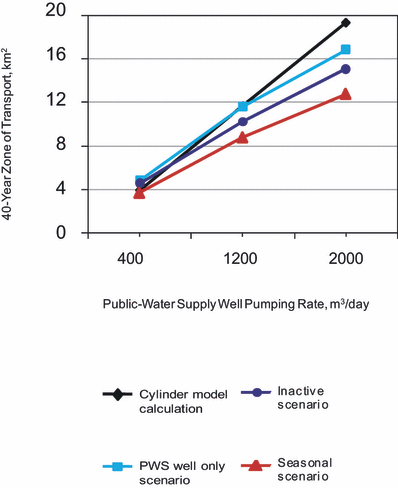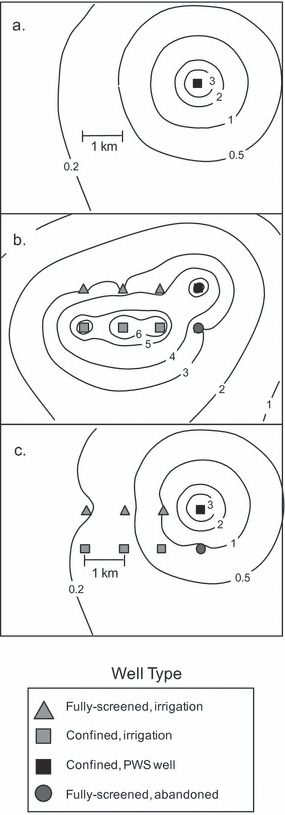Modeling the Potential Impact of Seasonal and Inactive Multi-Aquifer Wells on Contaminant Movement to Public Water-Supply Wells
- PMID: 22457571
- PMCID: PMC3307617
- DOI: 10.1111/j.1752-1688.2011.00526.x
Modeling the Potential Impact of Seasonal and Inactive Multi-Aquifer Wells on Contaminant Movement to Public Water-Supply Wells
Abstract
Wells screened across multiple aquifers can provide pathways for the movement of surprisingly large volumes of groundwater to confined aquifers used for public water supply (PWS). Using a simple numerical model, we examine the impact of several pumping scenarios on leakage from an unconfined aquifer to a confined aquifer and conclude that a single inactive multi-aquifer well can contribute nearly 10% of total PWS well flow over a wide range of pumping rates. This leakage can occur even when the multi-aquifer well is more than a kilometer from the PWS well. The contribution from multi-aquifer wells may be greater under conditions where seasonal pumping (e.g., irrigation) creates large, widespread downward hydraulic gradients between aquifers. Under those conditions, water can continue to leak down a multi-aquifer well from an unconfined aquifer to a confined aquifer even when those multi-aquifer wells are actively pumped. An important implication is that, if an unconfined aquifer is contaminated, multi-aquifer wells can increase the vulnerability of a confined-aquifer PWS well.
Figures




References
-
- Chen X, Yin Y, Goeke JW, Diffendal RF., Jr. Vertical Movement of Water in a High Plains Aquifer Induced by a Pumping Well. Environmental Geology. 2005;47(7):931–941.
-
- Clark BR, Landon MK, Kauffman LJ, Hornberger GZ. Simulations of Ground-Water Flow, Transport, Age, and Particle Tracking Near York, Nebraska, for a Study of Transport of Anthropogenic and Natural Contaminants (TANC) to Public Supply Wells. 2008. U.S. Geological Survey Scientific Investigations Report 2007-5068, Reston, Virginia. http://pubs.usgs.gov/sir/2007/5068/, accessed September 2010.
-
- Halford KJ, Hanson RT. User Guide for the Drawdown-Limited, Multi-Node Well (MNW) Package for the U.S. Geological Survey's Modular Three-Dimensional Finite-Difference Ground-Water Flow Model, Versions MODFLOW-96 and MODFLOW-2000. 2002. U.S. Geological Survey Open-File Report 2002-293, Reston, Virginia. http://pubs.er.usgs.gov/usgspubs/ofr/ofr02293, accessed September 2010.
-
- Hanson RT, Zhen Li, Faunt CC. Documentation of the Santa Clara Valley Regional Ground-Water/Surface-Water Flow Model, Santa Clara County, California. 2004. U.S. Geological Survey Scientific Investigations Report 2004-5231, Reston, Virginia. http://pubs.er.usgs.gov/usgspubs/sir/sir20045231, accessed September 2010.
-
- Harbaugh AW, Banta ER, Hill MC, McDonald MG. MODFLOW-2000, the U.S. Geological Survey Modular Ground-Water Model – User Guide to Modularization Concepts and the Ground-Water Flow Process. 2000. U.S. Geological Survey Open-File Report 2000-92, Reston, Virginia. http://pubs.er.usgs.gov/usgspubs/ofr/ofr200092, accessed September 2010.
LinkOut - more resources
Full Text Sources
